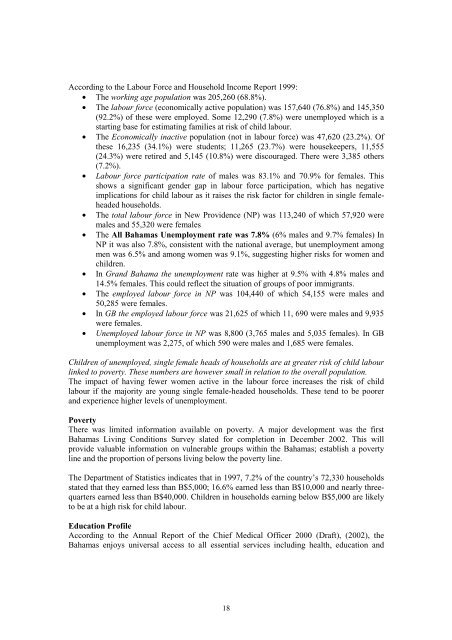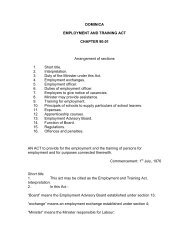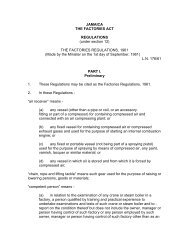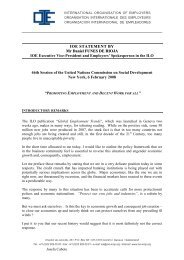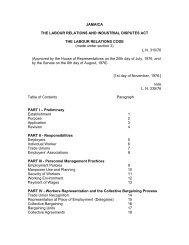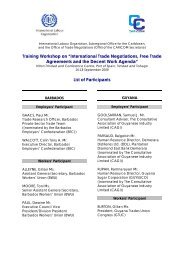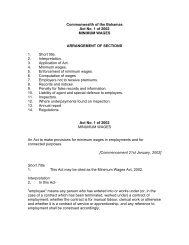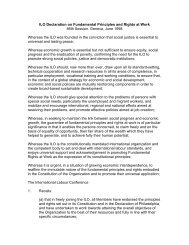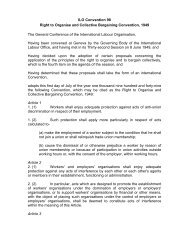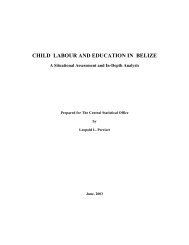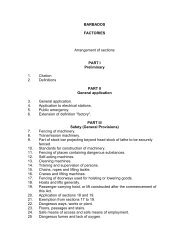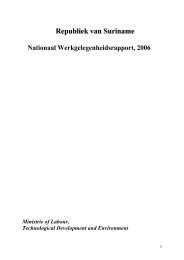ILO REPORT ON CHILD LABOUR IN BARBADOS - International ...
ILO REPORT ON CHILD LABOUR IN BARBADOS - International ...
ILO REPORT ON CHILD LABOUR IN BARBADOS - International ...
Create successful ePaper yourself
Turn your PDF publications into a flip-book with our unique Google optimized e-Paper software.
According to the Labour Force and Household Income Report 1999:<br />
• The working age population was 205,260 (68.8%).<br />
• The labour force (economically active population) was 157,640 (76.8%) and 145,350<br />
(92.2%) of these were employed. Some 12,290 (7.8%) were unemployed which is a<br />
starting base for estimating families at risk of child labour.<br />
• The Economically inactive population (not in labour force) was 47,620 (23.2%). Of<br />
these 16,235 (34.1%) were students; 11,265 (23.7%) were housekeepers, 11,555<br />
(24.3%) were retired and 5,145 (10.8%) were discouraged. There were 3,385 others<br />
(7.2%).<br />
• Labour force participation rate of males was 83.1% and 70.9% for females. This<br />
shows a significant gender gap in labour force participation, which has negative<br />
implications for child labour as it raises the risk factor for children in single femaleheaded<br />
households.<br />
• The total labour force in New Providence (NP) was 113,240 of which 57,920 were<br />
males and 55,320 were females<br />
• The All Bahamas Unemployment rate was 7.8% (6% males and 9.7% females) In<br />
NP it was also 7.8%, consistent with the national average, but unemployment among<br />
men was 6.5% and among women was 9.1%, suggesting higher risks for women and<br />
children.<br />
• In Grand Bahama the unemployment rate was higher at 9.5% with 4.8% males and<br />
14.5% females. This could reflect the situation of groups of poor immigrants.<br />
• The employed labour force in NP was 104,440 of which 54,155 were males and<br />
50,285 were females.<br />
• In GB the employed labour force was 21,625 of which 11, 690 were males and 9,935<br />
were females.<br />
• Unemployed labour force in NP was 8,800 (3,765 males and 5,035 females). In GB<br />
unemployment was 2,275, of which 590 were males and 1,685 were females.<br />
Children of unemployed, single female heads of households are at greater risk of child labour<br />
linked to poverty. These numbers are however small in relation to the overall population.<br />
The impact of having fewer women active in the labour force increases the risk of child<br />
labour if the majority are young single female-headed households. These tend to be poorer<br />
and experience higher levels of unemployment.<br />
Poverty<br />
There was limited information available on poverty. A major development was the first<br />
Bahamas Living Conditions Survey slated for completion in December 2002. This will<br />
provide valuable information on vulnerable groups within the Bahamas; establish a poverty<br />
line and the proportion of persons living below the poverty line.<br />
The Department of Statistics indicates that in 1997, 7.2% of the country’s 72,330 households<br />
stated that they earned less than B$5,000; 16.6% earned less than B$10,000 and nearly threequarters<br />
earned less than B$40,000. Children in households earning below B$5,000 are likely<br />
to be at a high risk for child labour.<br />
Education Profile<br />
According to the Annual Report of the Chief Medical Officer 2000 (Draft), (2002), the<br />
Bahamas enjoys universal access to all essential services including health, education and<br />
18


